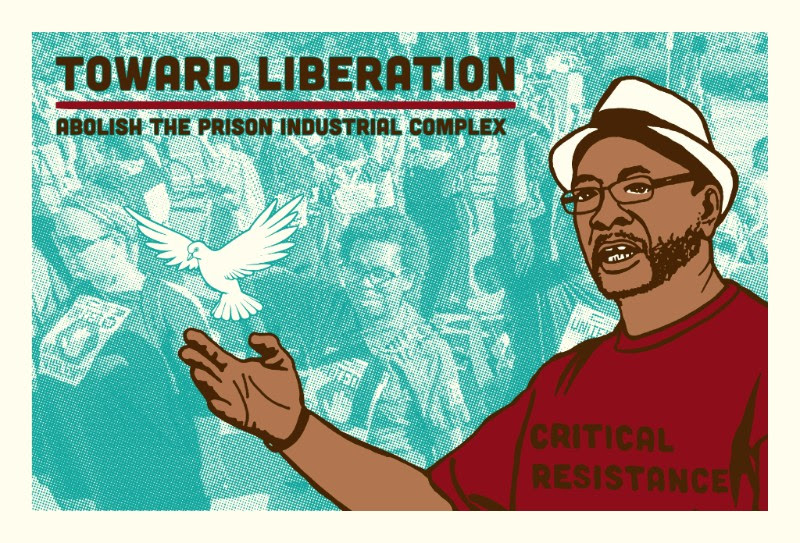Our first CR Donor Call of 2016 was a great success!* Thank you for joining us. If you missed it (or loved it), listen again here: Art and Abolition Donor Call audio file.
What are donor calls?
Each quarter CR hosts a donor call during which we discuss some current issues related to the prison industrial complex and strategies for resistance. The resources our donors contribute to Critical Resistance are essential to our fight against the prison industrial complex, so it is important for us to create spaces where we share back the strong work that your generosity makes possible. This is our first donor call of 2016 and we are inviting everyone to join! We hope you will be inspired to help keep CR thriving and growing by making a donation this year. Thank you for your continued support!
 Friday, May 6: Art and Abolition featured panelists Melanie Cervantes, kai lumumba barrow, and Ashley Hunt (bios below).
Friday, May 6: Art and Abolition featured panelists Melanie Cervantes, kai lumumba barrow, and Ashley Hunt (bios below).
Since the founding of Critical Resistance, we have modeled that cultural practice and art are critical components of the fight for prison industrial complex (PIC) abolition. The power of reclaiming culture taken from communities through centuries of colonization, genocide, and social and economic repression and the practices of creating are acts of resistance. The conversation explored the ways that Art and Abolition intertwine, and how cultural workers are helping us envision the world we want to live in and what we need to build to get there.
Here are a few gems from the call. Be sure to listen to the full audio recording to hear some history of CR’s visual politics, what these artists are working on and excited about now, and more. Listen to the full audio here.
P.S. Melanie Cervantes recently designed the beautiful poster (featured, above) for CR. Provide us your mailing address, and we’ll send it to you for free with our June newsletter! Click HERE to get your copy.
Ashley: “Let’s ask the question of ourselves as artists, how do we deplete the resources of the PIC through what we make? How do we force [the PIC] to be more useless? And then we ask the same question of our art pieces, ‘How can an artwork not call [in] the cops?'”
“Art, at its core, organizes. It organizes us visually and how we see the world; it can organize bodies, people, communities into a place.”
Ashley is currently reading “Mounting Frustration: The Museum in the Age of Black Power,” and he is excited about the current political moment where people are talking about the PIC and being more visible in resistance.
Melanie: “There is this impulse to reproduce imagery of confinement and surveillance; in collaborative settings this has come up and I’ve had to say “I don’t do that. It’s not useful.” Dignidad Rebelde chooses to reproduce images of [people as] agents of change, people actually chipping away at the PIC. We make works that elevate our sense of agency. It is useful to elevate ourselves as agents. It is disempowering to reproduce images of us at brunt of PIC or PIC visually winning.”
Right now, Melanie is excited about a print party that we are organizing in LA this spring with Critical Resistance- Los Angeles, Youth Justice Coalition, and SelfHelp Graphics. She is currently working on a show at Galeria de la Raza in the Mission district of San Francisco, which opens on May 7. Details here.
kai: “I’m asking people to go more into a space of abstraction…[when we make collaborative art], we do have to engage community in conversation, and not just be hired guns to reproduce what community wants/sees…[We have to engage in questions of each other] even when limited by white supremacy beauty standards, or [when someone who has been killed by police is] is frozen in time/of a certain age…Do we want to represent them frozen in time? Or by what they have done/given to movement and community? How to hold them visible and also holding [space] for the fact that they are no longer with us? In this politics of visibility and representation, we become limited by what we are told we have to think…”
“[Making art] is a radical, transgressive act: we are visualizing freedom. How do we take transgression and then facilitate more provocation, more transgression?”
kai is in the early stages of her next visual opera and is looking for collaborators (prisoners, people who work with people inside prisons, and more). It is an adaptation of “Woman on the Edge of Time” by Marge Piercy and “The Prisoner” by Luigi Dallapiccola. (Hear more at 1’07” of the call.) Learn more and check out the “Unbibliography” of past projects, here.
Our featured participants:
